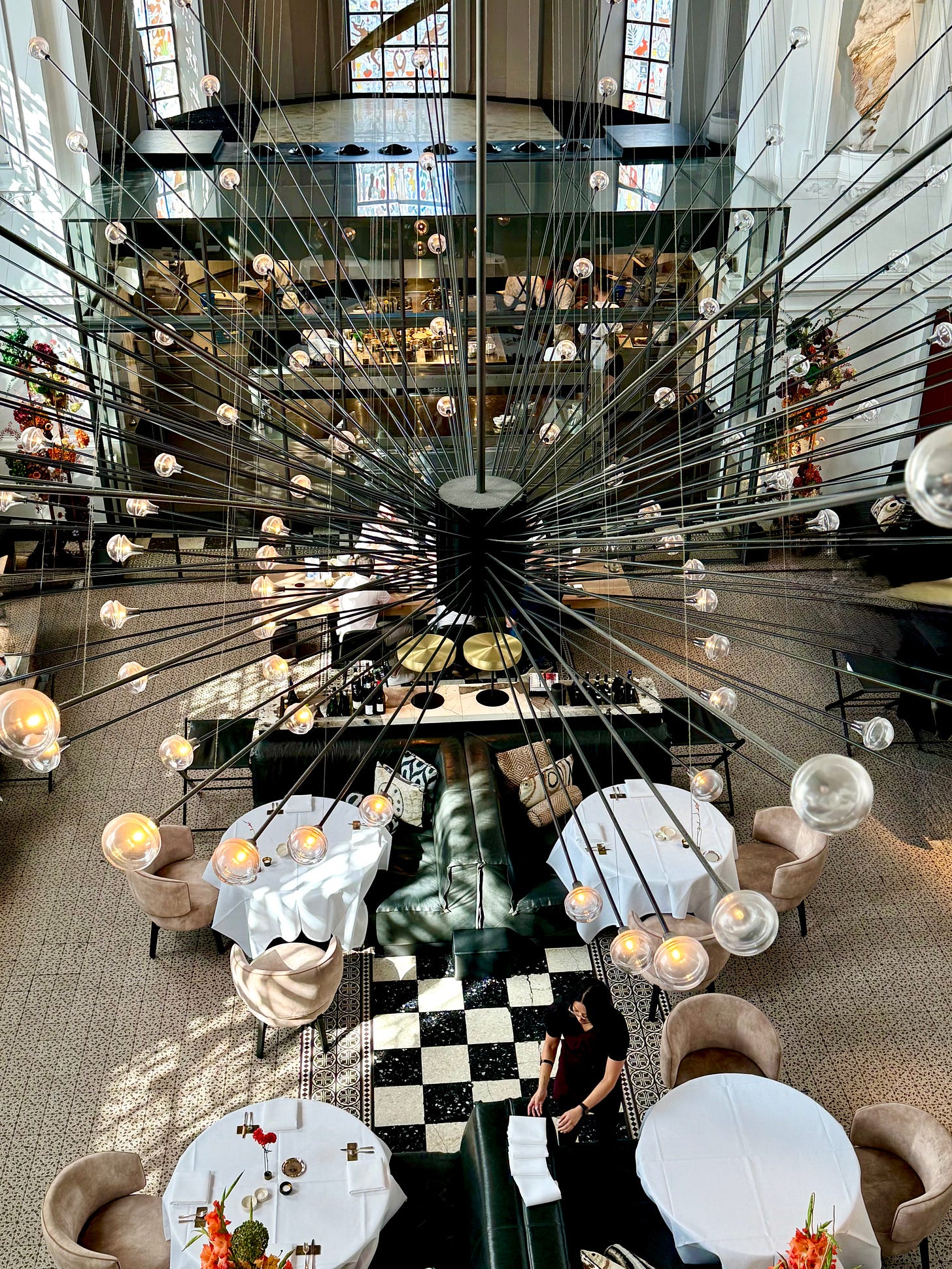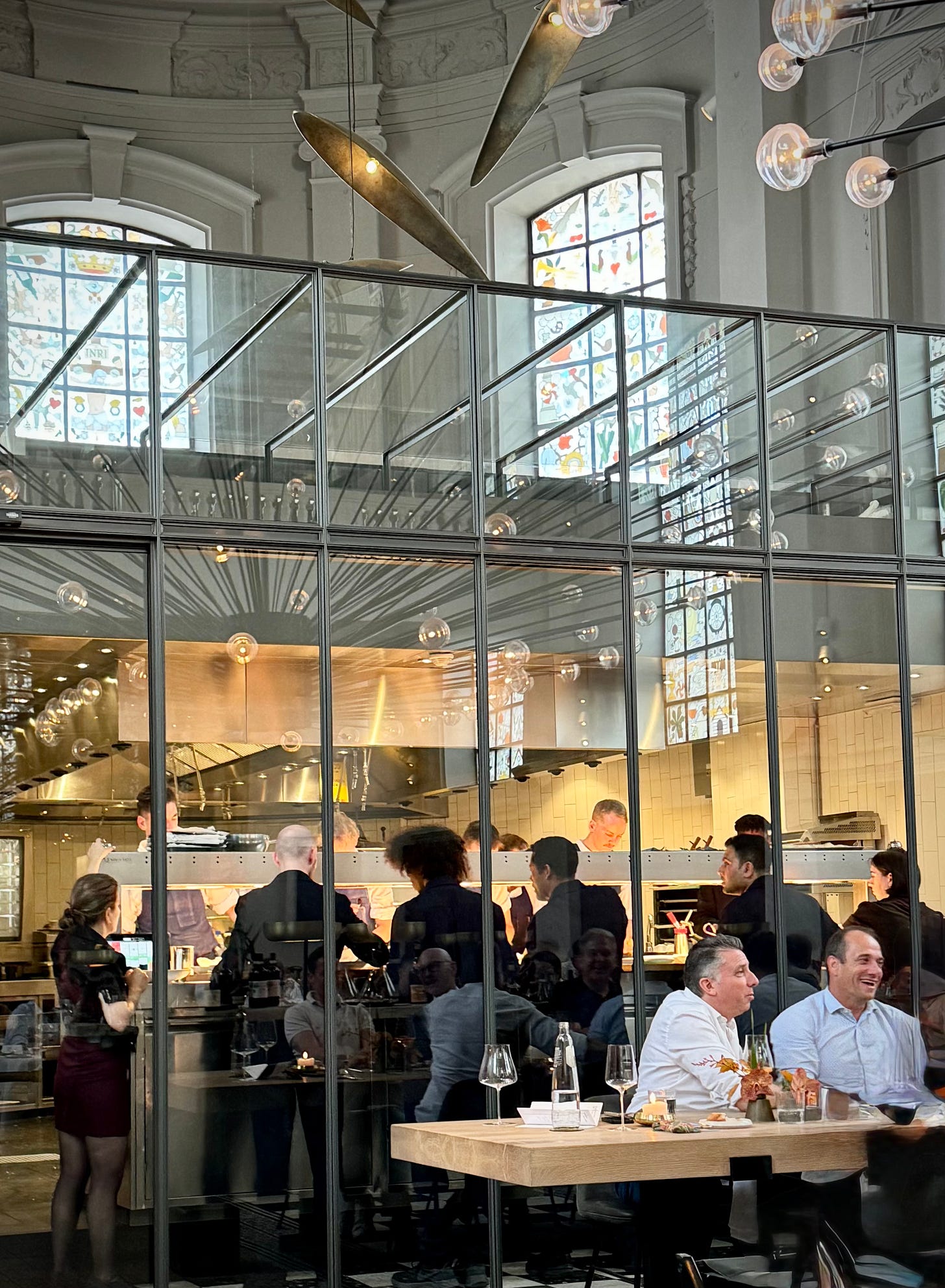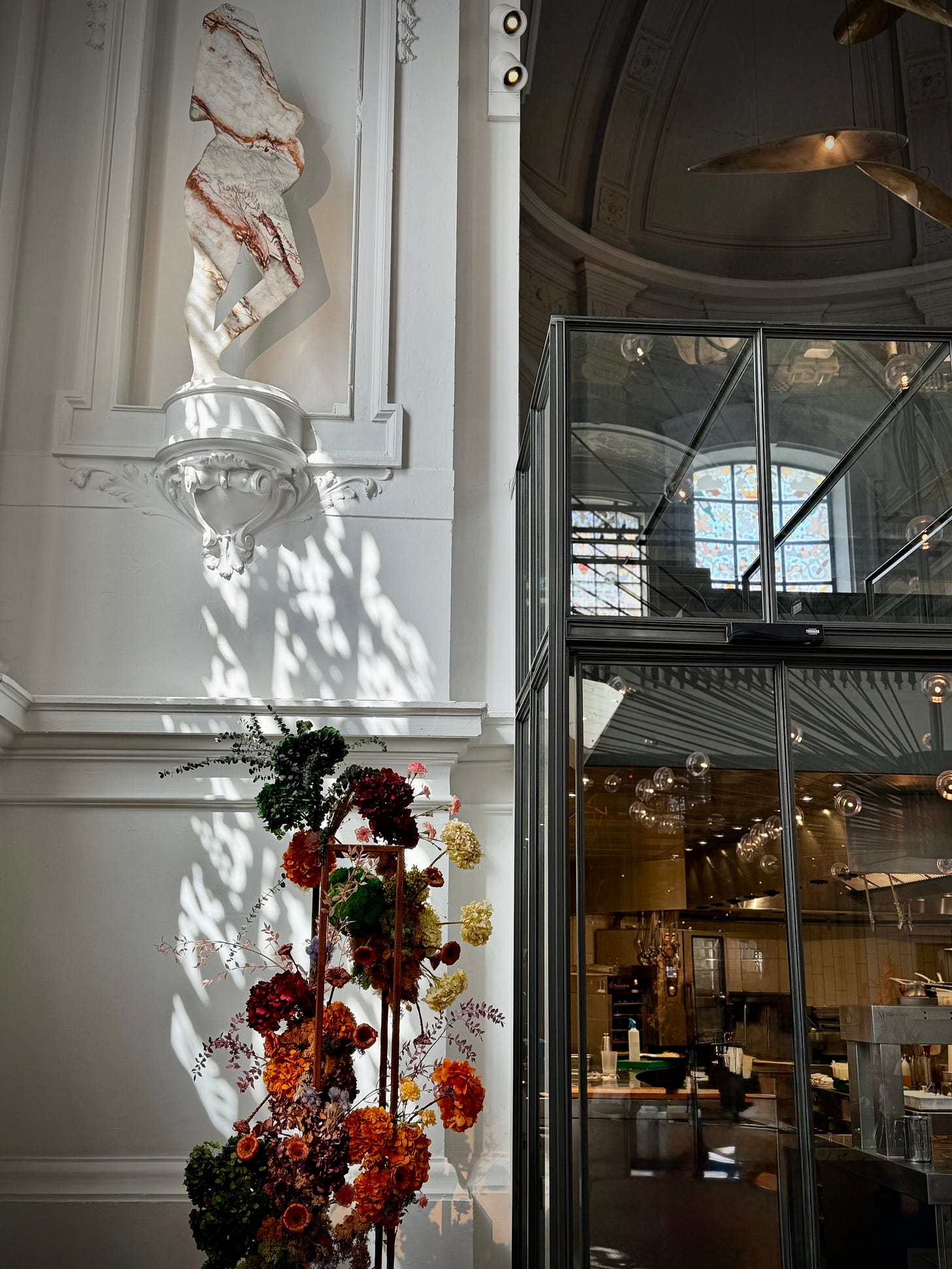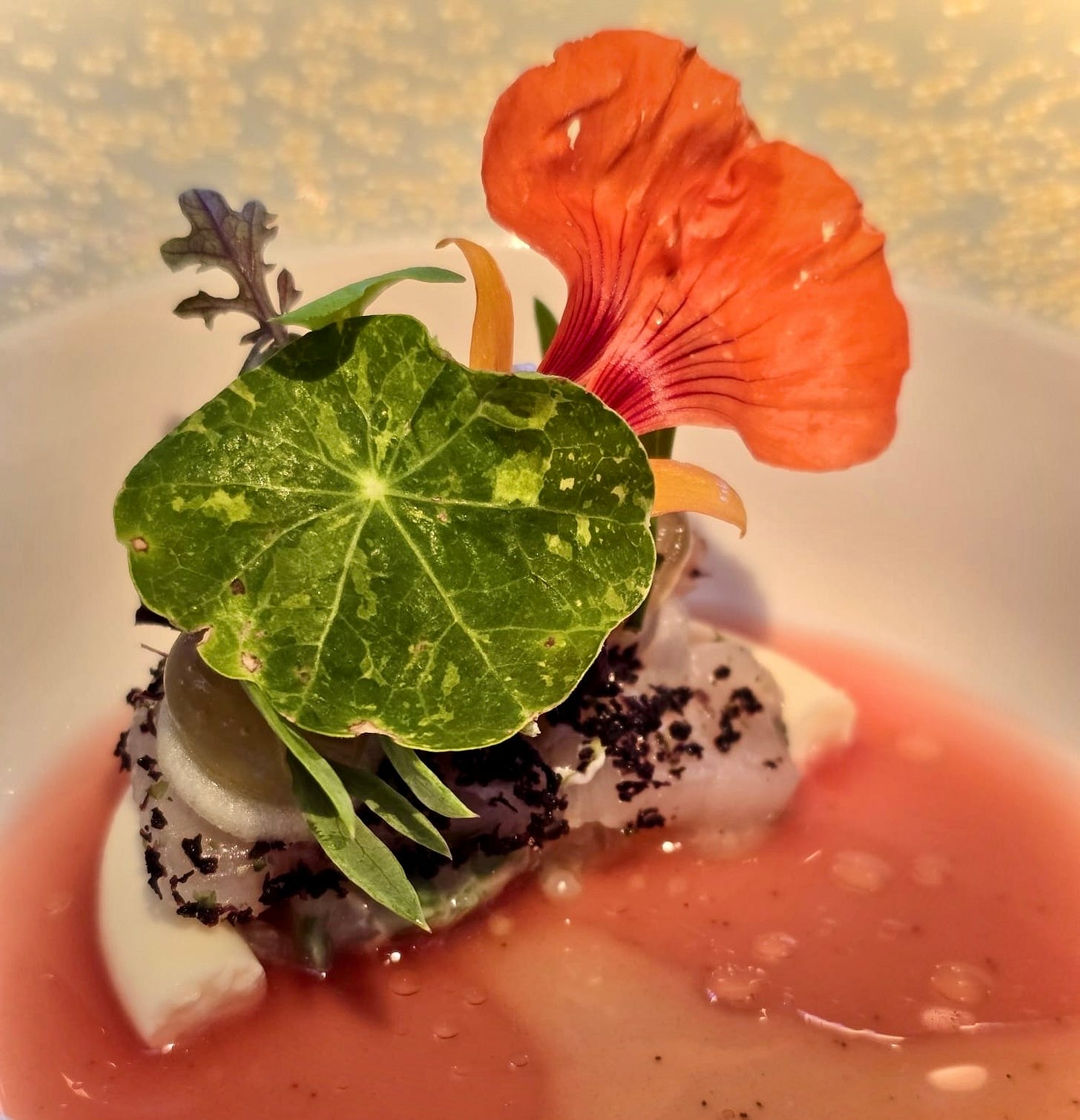25 for 25: What's in a number?
...the second installment in an occasional series about the art of hospitality
The second installment in my occasional series, 25 for 25, in which I share reflections on our quest to eat at the world’s best restaurants and the art of hospitality, in the world of food, and elsewhere.1
Last summer we went to Antwerp for lunch.
By now, this was old hat for us. After all, we’d flown to Modena for 36 hours to have dinner at Osteria Francescana, visited Vienna in December not for the Christmas markets but for Steirereck, planned an entire trip around a reservation at Noma.
In what may seem like caprice, frivolity, or a scene from The Menu, this lunch, in fact, was almost ten years in the making. But now the intent was different, matured beyond chasing glory or bragging rights.
A pilgrim’s progress
When we first charted that original map for eating, with restaurant rankings plotted next to latitude and longitude, our goals were simplistic. The excuse to go to as-yet-undiscovered destinations and broaden our cultural horizons along with our culinary ones. A deep dive into how long a tasting menu can really be—and how much food you can eat at one sitting. And always, a curiosity for what makes a meal truly memorable.
Yet in the early days of eating at these epicurean shrines, the markers for our own top scores were somewhat pedestrian. A checklist, if you will, of the more obvious kind. Ambience, service, food, value, our personal rankings shuffling the deck of which restaurants were tops in our books depending on those arbitrary attributes.
Of course, you say, but what else did you expect?
To be honest I didn’t really know. But as the map unfolded, the discoveries ran, and still run, far beyond the plate.
What’s in a number?
It didn’t take us long to reorder our priorities. It may well have been our dour experience at Osteria Francescana during that whirlwind visit. The food was, as anticipated, spectacular, playful, unexpected. And there the magic ended. Low marks for ambience: Massimo Bottura’s famous ebullience missing somehow in the small rooms, the dim lighting, the—wait, was that a Christmas song on the playlist in April?
The final blow of disappointment was the somber service: servers who explained the dishes mechanically, suffering through yet another tourist arriving with stars in their eyes.
What were we to make of the fact that it was ranked the number 3 restaurant in the world?
It got us thinking: what’s in a number? And more importantly, what makes a meal—and therefore a restaurant—great?
The human moment at work
Back to that lunch in Antwerp. On a trip through Belgium and France, we did what we’d done so many times before: secured a reservation at The Jane before booking our hotel room. The Jane, open since 2014, was one of only two restaurants in Belgium on the World’s Best list, clocking in at number 36. We were in.

With Sunday lunch at 12:30, we figured we’d have enough time to leisurely work our way through a stellar lunch and still take in some of the city’s amazing design-driven sights.
And then we were taken into the gentle and expert hands of The Jane’s service team. Thus unfolded an afternoon of joy and connection, in which the beautiful food dipped in and out of the starring role. Proof positive that playing the numbers game doesn’t always signal excellence.
Anyone who’s a chef, who loves food, ultimately knows that all that matters is: ‘Is it good? Does it give pleasure?’”
—Anthony Bourdain
It started with Rein, an American with a retail background who moved to Belgium for love and stayed because of The Bear.
On a trip back to the U.S. after her relationship ended, she was debating whether to return to Belgium or start fresh at home. A binge of The Bear tipped the scales: hospitality was her calling. A trial service at The Jane, and she was hired. And here we both were—she with her own starry-eyed optimism about hospitality, and we incredulous that The Bear, of all things, had convinced her this was the business to be in.
Then there was Sofie, a young server whose boyfriend was also the assistant sommelier. We learned that the two of them worshipped at the temple of fine dining, but from a decidedly different vantage point than ours. With camping trips as their preferred holiday, they always kept a change of fancy clothes in the car, ready to slip into a top restaurant whenever they could snag a table. Thanks to their hospitality connections—and the way service people gladly host one another—the lack of reservations was never an issue.
And on the afternoon went. Stories shared, favourite dishes debated; wines to try and connections to forge. Before we knew it, it was 5:30, and the sunlight that filled the vaulted ceiling of this former chapel had danced across the room. Antwerp would have to await another visit, another time when we could wander its cobbled streets and take in this thoroughly modern mix of avant-garde design and old secrets.
The wonderful meals we’ve been so very fortunate to experience have been part ballet, part magic show and all theatre. Watching a team working the room, gliding seamlessly around each other and between tables, is performance art, happening all around you.
Each employee – whether cooking in an open kitchen in front of you, or shyly describing a dish they’ve made, a wine they’ve selected, the provenance of your knife or edible flower – is partnering with you in your dining adventure and what they bring to the table goes far beyond the plate.
And we, the humble and hopefully always eager and grateful diner, are all the more richer for it.
So, what is in a number?
For many, “best of” numbers, lists and designations have lost some of their shine. More and more, they may be seen merely as guideposts, markers that help us decipher and choose where to eat from amongst an ever-increasing pool of restaurants that spring up like mushrooms, too numerous to count, too many to frequent.
But my experience tells me that those numbers, that designation, the industry recognition, not only bring in trade—they elevate the experience for everyone, and first and foremost for both the front of house and and those toiling behind the scenes. The pride we have seen time and again from restaurant teams who together have scaled the heights of recognition—perfecting the dance, making a diner’s bucket list meal a truly memorable one—can be the ballast when the shift drags, the guests are surly and unappreciative, and frankly, your feet are killing you.
I like to think what inspired Rein was the beautiful scene in The Bear where Richie is working the floor of a fine-dining restaurant, fully immersed in the flow of service. As he carries plates and checks on guests, he sees an opportunity to create a magic moment for someone. In that that diner’s unbridled delight, Ritchie realizes that it is in the little details, whether the anticipation of needs, or the way the team creates a seamless moment of joy for the diner, aren’t just tasks. It is hospitality not as work, but as an art of bringing happiness to others and taking full measure of it too.
Coda on The Jane
"This is far from the end. Trading in something familiar for something new is always daunting. But we're very excited about what's to come: an equally grand, yet more intimate concept that perfectly captures the spirit of our times. With the sky-high standards and hospitality you've come to expect from us," he says mysteriously.
Nick Bril, in Nieuwsblad, January 15, 2025
And with that, this past January, Executive Chef of The Jane, Nick Bril, announced that the current iteration of the 11-year-old restaurant would close its doors on March 16. But ardent fans and diners can now make a reservation at the highly anticipated Jane 2.0, opening October 5.
What I know for certain is that I’m not waiting for a ranking, a star, or any other number other than the reservation line to put it high on my list for a repeat visit.
If you liked this post, let me know by clicking the ❤️ button. It helps spread the word about Delicious Bits and brings me joy. Thank you, dear readers and eaters!
Sources:
Wikipedia
historyof.eu
The World’s 50 Best
nieuwsblad.be
All photos courtesy of the author
In revisiting these experiences, I’m also reflecting on the evolution of food, the nature of service and the theatre of dining; star chefs, cranky critics, and the role of social media in shaping our perception of what is truly great versus mediocrity disguised as genius. And most of all, what it means to share in hospitality from the diner’s side of the table.






A meal like that is a magical thing, one that will live on in memory for years. And now I'm hungry!
I suspect hospitality is one of your many talents… Perhaps an expertise. But, certainly your warm personality, supports at all income through in a post like this.